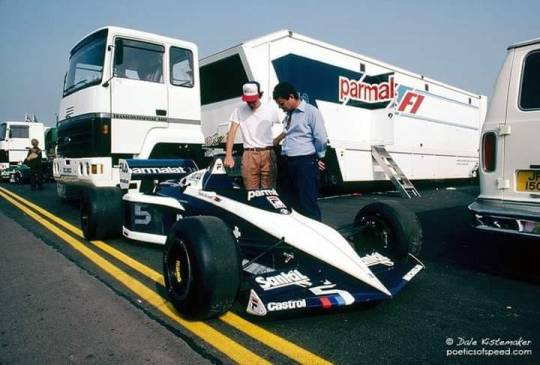#Brabham BT52
Text

1983 Brabham BT52
illustration by Sergio Baratto©
0 notes
Text
1983 GP of San Marino (Imola)🏁
Riccardo Patrese 🇮🇹 @PatreseOfficial, Brabham BT52 - BMW
#Formula1_classic
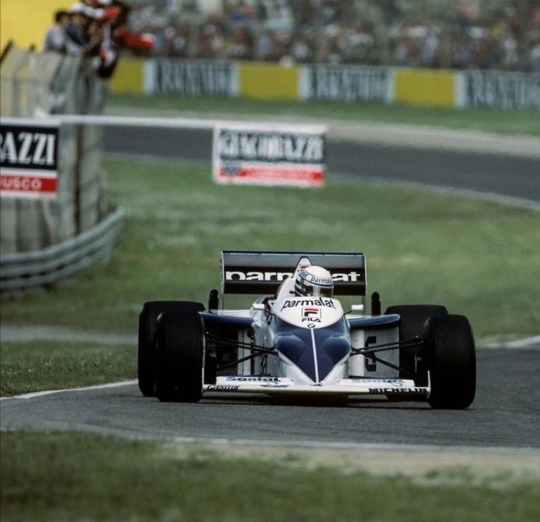
37 notes
·
View notes
Photo







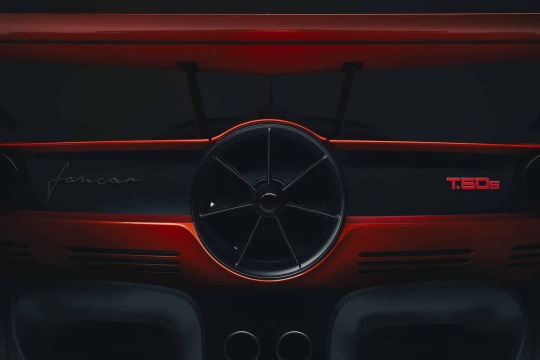


Gordon Murray T.50s Niki Lauda
Gordon Murray's T.50s track special, as expected, does not disappoint. In fact, while limited to just 25 units, the T.50s Niki Lauda comes with such a remarkable spec sheet that this side of attacking the track in a Formula 1 car, it should be nearly impossible to match its performance.
The list of wow factors begins with a power-to-weight ratio of 823 horsepower per tonne, only to continue with a rear fan that goes to maximum downforce mode at all speeds above 50 miles per hour. All GMA T.50s Niki Lauda models will be individually named after F1 victories of Murray designs, starting with chassis 01, the 1974 Kyalami (South African Grand Prix, Brabham BT44) car.
Gordon Murray says the T.50s project began some 18 months ago, and instead of just being a track-happy version of the road car, it's been a parallel design development. That translates to more aggressive aero changes instead of just add-ons, and 317 pounds shaved from the road car. The 4.0-liter Cosworth V12 is actually 35 pounds lighter in the Niki Lauda editions, while the six-speed manual gearbox is replaced by Xtrac's six-speed IGS paddle-operated race box.
With no body panel carried over from the "regular" T.50, the T.50s features a dominant central fin to enhance stability wearing Niki Lauda's logo, along with a delta-shaped fixed wing paying tribute to Murray’s 1983 Brabham BT52. Further enhancing the 15.74-inch fan's effect is the truly massive active diffuser.
Meanwhile, ground effect at the front is boosted by barge boards sculpted to improve airflow to the side ducts, an LMP1-style splitter, and Koenigsegg-rivalling dive planes. Despite Gordon Murray repeatedly referring to his Brabham fan car as a "blunt instrument," the rear grille features a "Fan Car" script next to the T.50s logo.
Still revving to 12,100 rpm, the Cosworth V12 of the T.50s Niki Lauda comes with revised cylinder heads and camshafts, plus a higher compression ratio of 15:1. GMA says weight-saving measures extend to the intake, exhaust and control systems, as well as the engine itself. All the valves are made from titanium, and there is no variable valve timing because this car is always in full attack mode.
A simpler induction system features 12 throttle bodies on top of the engine, fed directly by that racing-style air box. The exhaust system does without catalytic converters, has thinner Inconel walls, and, with only track noise limits to meet, benefits from smaller silencers.
The result is a specific output of 178 horsepower per liter for a total of 701 horsepower at 11,500 rpm, and 357 pound-feet of torque at 9,000 rpm. With the even bigger roof-mounted RAM induction airbox, maximum output goes up to 725 horsepower. GMA goes on to say that "right through the rev-range, it promises to be one of the greatest and most characterful sounding cars ever made."
Finally, GMA's bespoke Xtrac IGS (Instantaneous Gearshift) electronically actuated, six-speed, paddle-shift gearbox is 11 pounds lighter than the road car's manual transmission.
Brembo's carbon-ceramic brake discs measuring 370mm by 34mm at the front and 340mm by 34mm at the rear are carried over, along with their six- and four-piston calipers. Eighteen-inch forged magnesium center-lock wheels improve brake cooling, all while weighing 13.2 pounds each. GMA says the braking system, the slick Michelin tires, and the active aerodynamics combine to produce an eye-popping deceleration of 3.5g
36 notes
·
View notes
Text




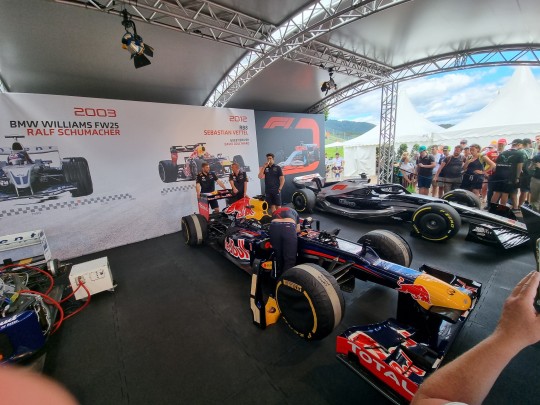
Some more classic F1 cars pics from Spielberg '22, featuring Ferrari 312B3, Lotus 79, Brabham BMW BT52, BMW Williams FW25 and barely seen Benetton B192 (ft my hands, a water bottle and my phone w/ my new Ferrari mask), and my BELOVED RB8 :)
#f1#classic f1#f1 cars#legends parade#austrian gp 2022#spielberg 22#ferrari#lotus#brabham bmw#bmw williams#benetton f1#red bull racing#rb8#lotus 79
6 notes
·
View notes
Text
How BMW Engine Technology Has Evolved Over The Years

BMW is a well-known brand for its high-performance engines, but how did it get there? Here is a brief overview of the history and evolution of BMW engine technology, from its origins in aircraft engines to its current innovations in electric and hybrid powertrains.
The first BMW engine: the IIIa aircraft engine (1917)
BMW stands for Bayerische Motoren Werke, or Bavarian Engine Works, and it was founded in 1917 as a manufacturer of aircraft engines. The first engine produced by BMW was the IIIa, a water-cooled inline-six engine with a carburetor that could deliver 185 hp. The IIIa had a sophisticated design that prevented loss of performance at high altitudes, and it was used by several German fighter planes during World War I. In 1919, BMW set an unofficial altitude record of 9,760 meters with the enhanced Motor IV model .
The first BMW motorcycle engine: the R 5 boxer engine (1936)
After World War I, BMW had to stop producing aircraft engines due to the Treaty of Versailles, so it switched to making motorcycle engines, farm equipment, household items and railway brakes. The first motorcycle produced by BMW was the R 32 in 1923, which featured a flat-twin boxer engine that became a signature feature of BMW motorcycles. The R 5, introduced in 1936, was a milestone in motorcycle engineering, as it had a 500 cc boxer engine with 24 hp and a valve control via two camshafts .
The first BMW car engine: the M78 straight-six engine (1933)
BMW entered the car market in 1928 by acquiring the Fahrzeugfabrik Eisenach, which produced the Dixi car based on the Austin 7. The first car to bear the BMW name was the 3/15, which used a four-cylinder engine from Austin. In 1933, BMW developed its own car engine, the M78, a straight-six engine with 1.2 liters of displacement and 30 hp. The M78 was used in the BMW 303, the first car to feature the kidney-shaped radiator grille that became another trademark of BMW .
The first BMW turbocharged engine: the M12/13 Formula One engine (1982)
BMW has a long history of involvement in motorsports, especially in Formula One, touring cars and endurance racing. One of the most successful engines that BMW developed for Formula One was the M12/13, a turbocharged 1.5-liter inline-four engine that could produce up to 1,400 hp in qualifying mode. The M12/13 powered the Brabham BT52 car driven by Nelson Piquet, who won the 1983 Formula One World Championship with three victories and nine podiums .
The first BMW V12 engine: the S70 McLaren F1 engine (1993)
BMW has also produced some impressive V12 engines for road cars, such as the M70 used in the BMW 750i and 850i models in the late 1980s and early 1990s. However, the most remarkable V12 engine that BMW ever made was the S70, a custom-built engine for the McLaren F1 supercar. The S70 was a 6.0-liter naturally aspirated engine that delivered 627 hp and enabled the McLaren F1 to reach a top speed of 386 km/h (240 mph), making it the fastest production car in the world at that time .
The first BMW diesel engine: the M21 inline-six engine (1983)
BMW was one of the pioneers of diesel technology in passenger cars, as it introduced its first diesel engine, the M21, in 1983. The M21 was an inline-six engine with a displacement of 2.4 liters and a power output of 86 hp. It was equipped with a Bosch injection pump and a Garret turbocharger, and it offered high fuel efficiency and low emissions. The M21 was used in several models such as the BMW 524td and the BMW E28 .
The first BMW hybrid engine: the ActiveHybrid X6 powertrain (2009)
BMW has also been experimenting with hybrid technology since the late 1990s, when it developed a concept car called the Z22 that featured an electric motor and a hydrogen fuel cell. In 2009, BMW launched its first production hybrid model, the ActiveHybrid X6, which combined a twin-turbocharged V8 petrol engine with two electric motors and a nickel-metal hydride battery pack. The ActiveHybrid X6 had a total system output of 485 hp and could run on electric power alone for up to 2.5 km (1.6 miles) .
The first BMW electric engine: the i3 powertrain (2013)
BMW has also been a leader in electric mobility, as it created a sub-brand called BMW i in 2011 to focus on developing electric and plug-in hybrid vehicles. The first model to be launched under the BMW i brand was the i3, a compact hatchback that featured an electric motor with 170 hp and a lithium-ion battery pack with a range of 130 to 160 km (80 to 100 miles). The i3 also offered an optional range extender, a small petrol engine that could charge the battery and extend the range by another 150 km (93 miles) .
The most powerful BMW engine: the S63 twin-turbocharged V8 engine (2019)
BMW has always been known for its high-performance engines, especially those developed by its motorsport division, BMW M. One of the most powerful engines that BMW M has ever created is the S63, a twin-turbocharged V8 engine with a displacement of 4.4 liters and a power output of 625 hp. The S63 is used in several models such as the BMW M5 Competition, the BMW M8 Competition and the BMW X5 M Competition, and it can propel these cars from 0 to 100 km/h (62 mph) in less than four seconds .
The most innovative BMW engine: the B38 inline-three engine (2013)
BMW has also been innovative in creating engines that are both efficient and powerful, such as the B38, an inline-three engine with a displacement of 1.2 to 1.5 liters and a power output of 75 to 231 hp. The B38 is part of a modular family of engines that share the same architecture and components, but vary in the number of cylinders and turbochargers. The B38 features technologies such as direct injection, variable valve timing and variable valve lift, and it is used in several models such as the BMW i8, the BMW 218i and the Mini Cooper .
Frequently Asked Questions (FAQs)
How has BMW's engine technology improved fuel efficiency over the years?
BMW achieved improved fuel efficiency through advancements such as direct fuel injection, lightweight materials, and efficient aerodynamics, reducing overall vehicle weight and optimizing engine performance.
What is Valvetronic technology, and how does it enhance engine performance?
Valvetronic technology replaces traditional throttle mechanisms, allowing precise control of the intake valves' lift. This optimization improves fuel efficiency and power delivery, enhancing overall engine performance.
Is BMW planning to expand its electric vehicle lineup further?
Yes, BMW has ambitious plans for expanding its electric vehicle lineup, focusing on developing new electric models and enhancing existing ones to meet the growing demand for sustainable transportation.
Are BMW engines still known for their high-revving nature and smooth power delivery?
Absolutely. BMW's M Division continues to produce engines with high-revving characteristics, delivering smooth power delivery and an exhilarating driving experience, ensuring the brand's legacy of performance excellence.
How does BMW balance performance and environmental concerns in its engine designs?
BMW achieves this balance through a combination of advanced engineering techniques, hybridization, and electrification. By integrating electric motors and optimizing combustion engines, BMW creates powerful yet environmentally conscious vehicles.
Read the full article
0 notes
Text
0 notes
Text
BMW Classic is going all out to celebrate Goodwood
BMW Group Classic, the historic branch of the German brand, will show off an old Brabham-BMW BT52 at the 80th Goodwood Members’ Meeting in mid-April on the famous English lawn.
It will smell good again nostalgia and the burnt gum in the park of Lord March, theater for decades of the mythical Goodwood Festival of Speed.
A tribute event
Mid-April, the famous Goodwood Members’ Meeting will…
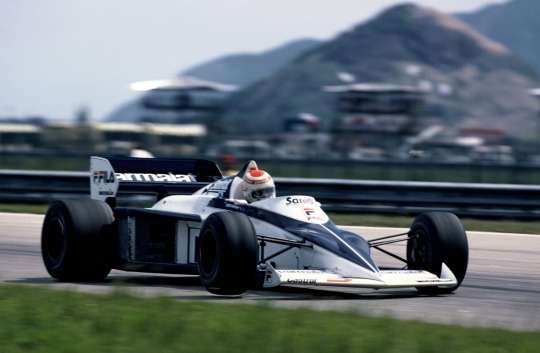
View On WordPress
0 notes
Photo

Brabham BT52
61 notes
·
View notes
Photo

Nelson Piquet, sliding his Brabham BT52 at the Belgian Grand Prix in 1983. He would finish fourth.
#Nelson Piquet#Brabham#Brabham BT52#Belgian Grand Prix#1983#F1#Formula 1#Formula One#Grand Prix#Grand Prix racing#Grote Prijs van Belgie#Spa#Spa-Francorchamps#Circuit de Spa-Francorchamps
129 notes
·
View notes
Photo

Nelson Piquet, Brabham-BMW BT52, 1983 Belgian GP, Spa-Francorchamps
9 notes
·
View notes
Video
The beautiful front wheel of the Brabham BT52B. A pleasure to reproduce 😍 #brabhamf1 #brabham #brabhambt52b #bt52b #bt52 #brabhambmw #nelson #piquet #f1drawing #f1 #retrof1 #classicf1 #formula1 #digitalartworks #digital #art #f1wheel #lastcornerprints https://www.instagram.com/p/B2m-895Hzfq/?igshid=td6aon3qfos3
#brabhamf1#brabham#brabhambt52b#bt52b#bt52#brabhambmw#nelson#piquet#f1drawing#f1#retrof1#classicf1#formula1#digitalartworks#digital#art#f1wheel#lastcornerprints
1 note
·
View note
Photo

brabhambt52_01 by RoscoPC http://flic.kr/p/UZrsKg
45 notes
·
View notes
Photo

New Post has been published on https://factory.sweb-demo.info/product/moc-0838-brabham-bt52
MOC-0838 Brabham BT52

Technic, MOC
0 notes

